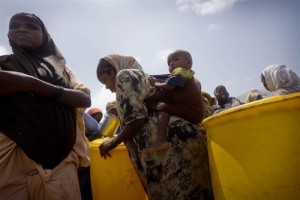WATER-BOURNE DISEASES ARE LETHAL THREAT TO CHILDREN IN SOUTHERN SOMALIA Rapid response needed as cholera cases increase
2011-08-18
Some 75 per cent of all cases of highly infectious acute watery diarrhoea are among children under the age of five. Poor sanitation conditions, a shortage of safe water, overcrowding and high malnutrition rates are the perfect combination for infectious diseases, such as cholera and pneumonia, to spread and increase death rates.
Cholera is confirmed in Banadir, Bay, Mudug and Lower Shabelle regions and the number of acute watery diarrhoea cases has increased dramatically in the last few months. Since January this year, some 4,200 cases of acute watery diarrhoea/cholera were reported in Benadir Hospital in Mogadishu alone.
 |
 |
Displacement disrupts outeak report “Our major concern is to monitor and detect new disease outeaks in the many informal settlements set up by internally displaced people in and around Mogadishu,” said Dr. MartheEverard, WHO Representative for Somalia. “For the last few years, a network of health workers reporting to the early warning system has been in place, however they report through a health facility or mobile clinic. Yet the large numbers of displaced people in Mogadishu are making it more difficult to record the various diseases.”
“We urgently need more mobile clinics that will provide basic health care services to the many displaced and who will strengthen the reporting on new outeaks. This is critical to our response and our ability to save lives,” she added.
Cholera is endemic in Somalia but the last major outeak was in 2007 with 67,000 cases.In recent years, efforts to chlorinate the water supply of Mogadishu, along with efforts to improve hygiene and sanitation prevented a serious outeak. But there is now an acute shortage of safe water and adequate sanitation with the influx of 100,000 people this year into Mogadishu, inging the total number of displaced people in the capital to 470,000 with many living in overcrowded settlements.
“There is no need for a child to die of diarrhoea, yet this is a tragic reality for a Somali child who is acutely malnourished. It is a lethal combination,” said RozanneChorlton, UNICEF Representative for Somalia. “These types of diseases can be prevented and treated quickly. To save children’s lives we are making sure that safe water, sanitation and hygiene along with early access to primary health care are an integral part of our emergency response.”
Medical supplies arrived in affected communities Emergency diarrhoeal disease kits made up of medical supplies such as syringes, infusions, and oral rehydration salts (ORS), already prepositioned by UNICEF and WHO,have been sent to 13 hospitals.An additional 200 diarrhoeal disease kits, each able to treat 100 severe and 400 moderate cases are being procured and should be in southern Somalia in the next few weeks. These items would enable partners in the health and in the water and sanitation sectorsto respond to up to 100,000 cholera cases including 80,000 moderate and 20,000 severe cases.
In addition, case management of severe dehydration with and without malnutrition is being strengthened and the focus is now on mobilizing a network of community health promoters to move from door to door with health hygiene education messages. Health posts are being stocked with essential medicines and ORS.
Many of southern Somalia’s rural and urban areas rely on shallow wells, which - unless they are protected or treated with chlorine - can be a perfect eeding ground for water-borne diseases.
Partners in the water, sanitation and hygiene sector are scaling up to target 1.5 million people across high risk areas of the South. Supplies of chlorine and essential items for hygiene and household treatment and storage of water are being distributed. Already 217 water sources are being chlorinated, and 58 water point outlets are benefitting 483,200 people and internally displaced people in Mogadishu.
In addition, household hygiene supplies, including water purification tablets, soap and buckets, enough for 48,000 families, are being distributed at existing feeding centres for malnourished children. Campaigns to educate families about the treatment of drinking water, safe disposal of waste and encourage hand washing with soap will also be scaled up in high risk communities.
Donation appeal As part of the updated 2011 UN Consolidated Appeal for Somalia, an estimated HK$624 million (US$80 million) is needed for the health sector and over HK$608 million (US$78 million) is required for the water, sanitation and hygiene sector. So far only 30 percent and 37 percent respectively has been raised for each sector.









